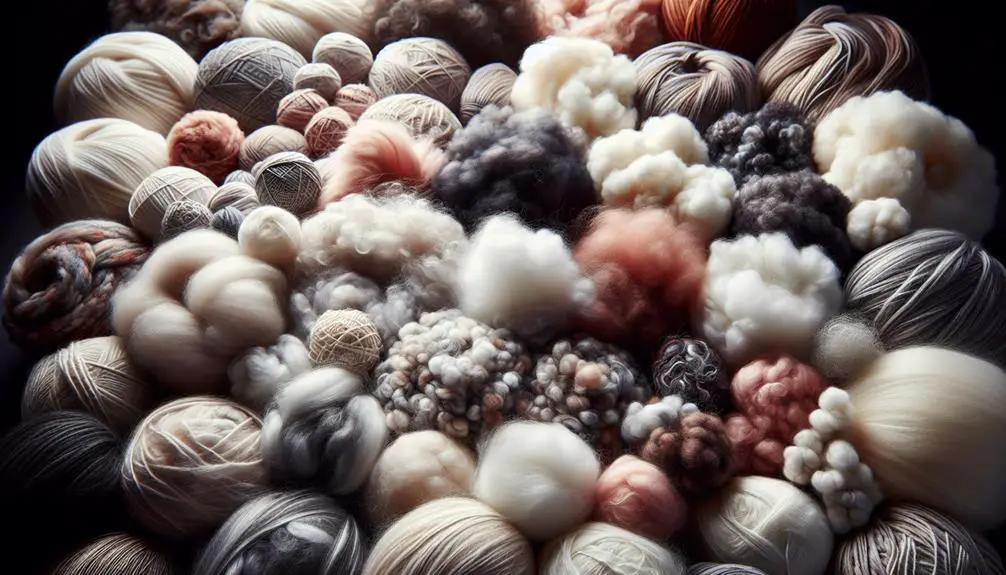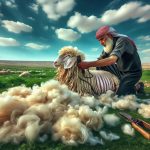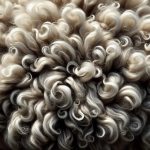Wool is a versatile material from animals like sheep, camels, goats, and rabbits. It's soft, warm, durable, breathable, and resists wrinkles. Different types of wool fibers, like cashmere and mohair, have unique qualities. Wool's great for insulation, comfort, and air circulation in products. Explore further for the interesting world of wool varieties, production process, and the many benefits it offers.
Table of Contents
Key Takeaways
- Wool is a versatile material sourced from animals like sheep, camels, goats, and rabbits.
- Key features include softness, insulation, durability, breathability, and wrinkle resistance.
- Different types of wool fibers include cashmere, mohair, and angora.
- Wool provides excellent insulation, comfort, and air circulation.
- Production process involves shearing, cleaning, carding, and spinning fibers into yarn.
Origins of Wool
Wool, originating from the hair of sheep and other animals, is a versatile material with diverse uses. The primary source of wool is the fleece of sheep, which is sheared annually to collect the fibers. This natural fiber is also obtained from animals like camels, goats, and rabbits. The fleece of sheep provides an abundant and renewable source of wool that has been utilized for centuries in various applications.
Sheep are specifically bred for their wool-producing capabilities, with different breeds offering fibers of varying qualities. For example, Shetland wool is renowned for its fine texture, allowing it to be spun as delicately as silk. The process of shearing is essential in harvesting wool from sheep, ensuring that the animals are relieved of their heavy, warm coats in a humane manner. Innovations in wool harvesting, such as methods that enable wool to naturally fall off sheep without shearing, are also emerging in the industry. Wool's origins in the fleece of sheep highlight its sustainable and valuable nature in the textile world.
Wool Characteristics and Properties
Exploring the wonderful world of wool reveals a myriad of characteristics and properties that make this natural fiber truly remarkable. When it comes to fine wool, here are some key features that set it apart:
- Softness: Fine wool is known for its luxurious softness, making it comfortable to wear against the skin.
- Insulating: This type of wool provides excellent insulation, keeping you warm in cold weather and cool when it's hot.
- Durable: Fine wool fibers are strong and resilient, making garments made from this material long-lasting.
- Breathable: Fine wool allows air to circulate, preventing overheating and ensuring comfort throughout the day.
- Wrinkle-resistant: Clothes made from fine wool tend to resist wrinkles, maintaining a neat and polished look with minimal effort.
Fine wool truly embodies the best qualities of this natural fiber, offering a combination of comfort, durability, and style.
Different Types of Wool Fibers
Sheep's fleece isn't the only source of wool fibers; goats, rabbits, and other animals also contribute to the diverse range of wool types available. These fibers are used to make specialty wools like cashmere, mohair, and angora, each offering unique characteristics for various products.
Cashmere, sourced from goats, is known for its exceptional softness and warmth, making it ideal for luxurious garments. Mohair, derived from goats as well, is valued for its luster and durability, often used in high-end textiles. Angora wool, from rabbits, is prized for its silky texture and lightweight feel, commonly used in soft, fluffy clothing items.
Understanding the different types of wool fibers is essential in selecting the right material for specific applications. Variations in thickness, softness, and durability impact how the wool performs in different products, influencing factors like comfort, insulation, and longevity. By considering the origin and characteristics of each type of wool fiber, artisans and manufacturers can create items that meet the desired standards of quality and functionality.
Wool Production Process
When it comes to wool production, we start with shearing the animals to obtain the fibers.
The next steps involve cleaning and carding the wool to remove impurities and align the fibers.
Sheep to Yarn
As we explore the wool production process, the initial step involves shearing the fleece of sheep. This fleece is then transformed into yarn through several key steps:
- Washing the wool to remove dirt and grease.
- Spinning the clean wool fibers into yarn suitable for weaving.
- Supporting various industries like clothing and carpet making.
- Producing specialty wools like cashmere from goats in a similar process.
- Creating a sustainable and versatile material that has been used for centuries.
The journey from sheep to yarn is a fascinating process that highlights the importance of wool in our everyday lives.
Cleaning and Carding
After shearing the fleece of sheep, the next step in the wool production process involves cleaning and carding the wool fibers to prepare them for spinning.
Cleaning wool is essential to remove impurities like dirt, grease, and vegetable matter from the fleece. This process typically includes using water, detergent, and mechanical agitation to make sure the wool is clean and ready for further processing.
Once the wool is clean, carding comes into play. Carding aligns and smooths the fibers, creating a uniform texture that makes them easier to spin into yarn. This step is vital for producing high-quality wool products with consistent and desirable characteristics.
Proper cleaning and carding set the foundation for the rest of the wool production process, ensuring a superior end product.
Spinning Fibers Into Yarn
I start by washing the wool fiber to remove impurities like dirt and grease before spinning it into yarn using various techniques.
Different spinning methods include hand spinning, machine spinning, and worsted spinning.
Spinning twists the fibers together to create a continuous strand of yarn.
The thickness and strength of the yarn depend on the spinning technique used.
Wool fibers are often blended with other fibers like silk or cotton before spinning for unique properties.
After spinning, the yarn is ready to be dyed and used in various textile applications.
Benefits of Using Wool
With its natural insulating properties and moisture-wicking abilities, wool stands out as a versatile and comfortable choice for clothing and bedding. Wool acts as an insulator, keeping you warm in colder temperatures by trapping air within its fibers, and it also helps regulate your body temperature in warmer conditions by wicking away moisture and allowing your skin to breathe.
This natural fiber is also moisture-wicking, meaning it can absorb and release moisture without feeling damp, keeping you dry and comfortable. Additionally, wool is naturally odor-resistant, allowing you to wear it multiple times without washing, which isn't only convenient but also helps conserve water and energy.
Furthermore, wool is fire-resistant, making it a safe choice for clothing and bedding, providing an added layer of protection. Its biodegradable and renewable nature also makes wool an environmentally-friendly option, aligning with sustainable practices. Wool truly offers a blend of comfort, functionality, and eco-friendliness, making it a top choice for various applications.
Wool Vs. Other Natural Fibers
Moving from the discussion on the benefits of using wool, it's interesting to compare wool with other natural fibers to understand their unique characteristics and advantages. When considering the properties of wool against other natural fibers, some key points to note are:
- Durability: Wool is more durable compared to many other natural fibers, making it a long-lasting choice for various products.
- Flame Resistance: Wool has natural flame-resistant properties, unlike some other natural fibers that may be more flammable.
- Water Repellency: Wool possesses natural water-repellent qualities, which aren't commonly found in other natural fibers.
- Versatility: Wool is highly versatile and can be used in a wide range of products, from clothing to carpets, showcasing its adaptability.
- Heat Retention: Wool is excellent at retaining heat, a feature that's widely used in creating warm and cozy items for various purposes.
Understanding these distinctions can help in appreciating the unique benefits that wool offers over other natural fibers.
Sustainable Aspects of Wool
Sustainable practices in wool production highlight its eco-friendly attributes and positive impact on the environment. Wool is a sustainable material sourced from sheep, making it biodegradable and renewable. Compared to synthetic fibers like polyester, wool production has minimal environmental impact. Sheep farming for wool can also help maintain grasslands and support biodiversity. Additionally, wool's natural fire resistance reduces the need for chemical flame retardants, further enhancing its sustainability. The durability and longevity of wool products contribute to reducing waste, making them a smart choice for environmentally conscious consumers.
| Sustainable Aspects of Wool | |
|---|---|
| Biodegradable | Renewable source |
| Minimal environmental impact | Supports biodiversity |
| Fire-resistant | Durable and long-lasting |
Wool in Fashion and Textiles
Wool plays a significant role in shaping the trends of the fashion and textile industries due to its versatility and timeless appeal. When it comes to integrating wool into fashion and textiles, here are five key points to keep in mind:
- Winter Wardrobe Staples: Wool garments like sweaters, coats, and scarves are popular choices for winter wear due to their excellent insulating properties.
- Blend of Fibers: Wool is often blended with other fibers like cotton, silk, or synthetics to enhance its performance and texture, creating unique fabric compositions.
- Merino Wool: High-quality wool fabrics, such as merino wool, are highly valued for their softness, breathability, and moisture-wicking abilities, making them ideal for various clothing items.
- Designer Appeal: Designers frequently incorporate wool into their collections for its natural elegance, draping qualities, and the beautiful way it takes dyes.
- Timeless Elegance: Wool exudes a sense of timeless elegance, making it a classic choice in the ever-evolving world of fashion and textiles.
Care and Maintenance of Wool Items
When tending to wool items, it's important to handle them gently to preserve their quality and longevity. Wool should be hand washed in cool water to prevent shrinking and damage. Harsh chemicals or bleach should be avoided during cleaning to maintain the wool's integrity.
To dry wool items, lay them flat to retain their shape and prevent stretching. A soft bristle brush can be used to remove lint or debris from wool without causing damage. Storing wool items in a cool, dry place with good ventilation is essential to prevent mold and moth damage.
Fun Facts About Wool
Let's talk about some fun facts about wool.
Did you know that wool can be sheared from sheep once a year, with prices ranging from $300 to $400 per kilo?
It's pretty cool that wool has historical significance in wartime for its durability and insulation properties, right?
Stay tuned as we explore more about the production process, benefits, and care tips for this amazing natural fiber!
Wool Production Process
As the wool production process unfolds, fibers are sheared, washed, and spun to create the versatile material we all know and love. This intricate process involves several steps that are essential to producing high-quality wool:
- Shearing: Removing the wool from animals like sheep, goats, and rabbits.
- Cleaning: Washing the wool to eliminate dirt, grease, and impurities.
- Spinning: Transforming the cleaned wool fibers into yarn for weaving or knitting.
- Specialty Wool: Different animals contribute to specialty wool production, each with unique characteristics.
- Labor-Intensive: Wool production demands skill and care to maintain the quality of fibers, making it a labor-intensive process.
Benefits of Wool
Let's explore some fascinating facts about wool that highlight its amazing benefits for both clothing and home goods. Wool is a natural fiber that offers a variety of advantages, making it a popular choice for many products. Here are some key benefits of wool:
| Benefits of Wool | |
|---|---|
| Breathable | Wool is breathable, allowing air to circulate and helping to regulate body temperature. |
| Moisture-wicking | Wool can absorb moisture without feeling wet, keeping you dry and comfortable. |
| Odor-resistant | Wool has natural properties that resist odors, making it a great choice for long-lasting freshness. |
| Renewable & Biodegradable | Wool is renewable and biodegradable, making it an eco-friendly option for sustainable living. |
| Flame-resistant | Wool is naturally flame-resistant, providing an added safety feature in various products. |
Wool Care Tips
To care for wool effectively, it's essential to follow specific guidelines to maintain its quality and shape. Here are some tips to help you keep your cotton wool items in top condition:
- Hand wash or dry clean wool to preserve its quality.
- Avoid hot water and harsh detergents to prevent shrinkage.
- Air dry wool items flat to prevent stretching.
- Store wool garments folded to maintain their shape.
- Use a soft brush or lint roller to keep wool fabrics free of lint and debris.
Frequently Asked Questions
What Is the Simple Definition of Wool?
To keep it simple, wool is the soft hair from sheep and other animals. It's used for making clothes, blankets, and carpets. It can sometimes make people itch due to its texture.
What Does It Mean to Be Called a Wool?
When called a 'wool,' it means I'm seen as genuine, excellent, and sincere. Being 'wool' signifies authenticity and quality. I'm considered trustworthy and reliable. 'All wool and a yard wide' describes me as truly genuine and high quality.
What Is the Meaning of Woolen?
Sure, when I hear "woolen," I think of warm, cozy fabrics like sweaters. They're soft and perfect for chilly days. Woolen items can be handmade or machine-made, offering various textures and warmth levels.
What Does Wool Mean a Sentence?
Using wool in a sentence showcases its versatility. From cozy sweaters to warm blankets, wool offers comfort and style. Animals like sheep, goats, and rabbits provide this luxurious material that elevates everyday items.






